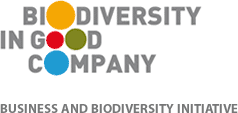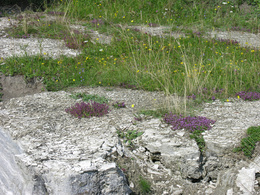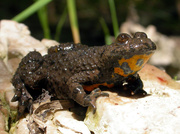Business and Biodiversity: Knauf Gips KG

Knauf Gips KG
Commitment
"Since our company "Rheinische Gipsindustrie und Bergwerksunternehmen" was founded in 1932, conservation of nature, despite mining activities, has been a top priority. Sustained success is not possible without responsible use of natural resources. This was and is one of the most important corporate objectives of Knauf and will also remain so in the future." - Alexander Knauf & Manfred Grundke (Managing Directors, Knauf Group)
Knauf has been quarrying natural gypsum for more than 80 years. These resources are extracted from small or large quarries at sites where they occur and are used as raw materials by various processing plants. Although itself is temporary limited, it inevitably involves a considerable impact into nature and the environment. Most of the sites that are mined are later recultivated and then generally used for agricultural or forestry purposes.
Since its founding, Knauf has been committed to exceeding the legal regulations and actively practicing nature protection. However, the principal and definition of the "nature protection" has undergone a transformation. Until the '90s it was understood to mean "a harmonious integration into the countryside" and the recultivation of the used land for a "meaningful agricultural purpose". The guiding idea was to "close the wound in the landscape". Nowadays, classic recultivation has to compete with a new take on nature protection.
"People have started to rethink nature protection and raw materials management since it has become increasingly clear that rare species of animals and rare types of plants are finding sanctuaries in our habitat, quarries that have been left open or that are even still in operation." - Bernd Raab (Geobotanist, LBV)
"... biodiversity – previously referred to simply as rich animal and plant life – became a key issue for us in the mid-80s. People realized that renaturalized and active quarries and gravel pits could be used as oases for rare species of animals and plants in a way that filled and recultivated quarries and pits could not. Keywords even then were protosoil site, pioneer species, migratory biotope, eagle owl and yellow-bellied toad..." - Prof. Matthias Reimann (Head of Raw Materials Management & Environment, Knauf Gips KG)
Knauf has been working hand in hand with the Landesbund für Vogelschutz Bayern e.V. (LBV), a regional federation for the protection of birds in Bavaria. A pilot project to promote gypsum steppes in Bavaria in 1991 has developed into an extensive program of cooperation in the planning and implementation of restoration measures between Knauf Gips KG, municipal nature protection and private nature protection.
Other cooperations have also been formed between nature protection organizations and industrial associations. Knauf, together with other companies from the building materials and raw materials sector, is an active member of the working group "Lebensraum Steinbruch und Kiesgrube" (Quarry and Gravel Pit Habitats) of the LBV and is involved in the practical implementation of nature protection work in quarrying areas. In the "Frankenbündnis", Knauf cooperates with other companies to assist LBV with programs to promote environmental education for children and adults.
At national level a concept was developed, jointly with the "Bundesverband Baustoffe – Steine und Erden e.V." (BBS) and "Naturschutzbund Deutschland e.V." (NABU), for migratory biotopes in quarrying sites. At European level, Knauf Gips KG supports the association EUROGYPSUM in establishing a uniform biodiversity indicator kit for the monitoring of active quarrying sites.
Knauf is currently collaborating with the "Industrieverband Steine & Erden Baden-Württemberg e.V." (ISTE) to set up a biodiversity database to collate, unify and analyze the extensive data sets on flora and fauna in the quarrying sites. "We are really quite proud to have been one of the driving forces behind these topics from the start – before the much-lauded Rio conference highlighted the issue." - Prof. Matthias Reimann (Head of Raw Materials Management & Environment, Knauf Gips KG)
Knauf's Motivation
In the meantime promoting biodiversity has become a matter close to the heart of Knauf. With land usage becoming increasingly unified and intensive, habitats are also becoming more and more alike. Ultimately, this means that our environment is becoming more degraded, ecosystems are losing the ability to provide several services, and quality of life is diminishing - for us and for later generations.
Due to their special habitats, quarries - whether disused or still in operation - are increasingly important as sanctuaries for endangered animals and plants, and contribute in a considerable measure to linking biotope islands, also with regard to NATURA 2000. An additional employee, specially trained in ecology and nature protection, has been working for Knauf on this issue since 2013. Membership of Biodiversity in Good Company is also intended to heighten awareness and assist in getting people to think more about the necessity of biological diversity: A contribution to the German "National Strategy for Biodiversity" and "Biodiversity Strategy 2020" of the EU.
FactBox Knauf Gips KG

Headquarters
Iphofen, Germany
Major Products
Extractive industry, building materials industry, gypsum plasterboard, gypsum plaster
Global turnover 2013
6 billion Euro
Global employees 2013
25.000
Further information & good practice
Biodiversity Stewardship in Gypsum Quarrying: Our Best Practices - Brochure of EUROGYPSUM with best practices of Knauf.
Performance indicators framework for biodiversity management in gypsum quarries throughout europe - Brochure of EUROGYPSUM with contribution of Knauf.

